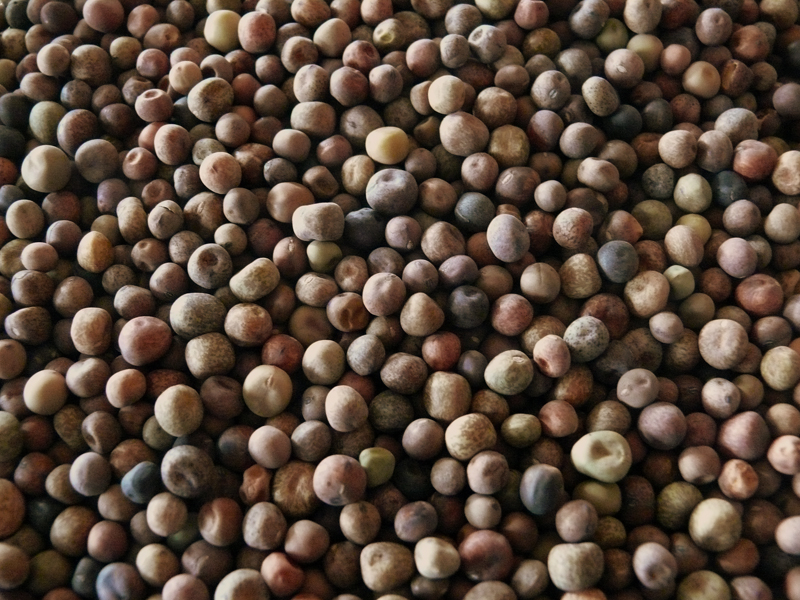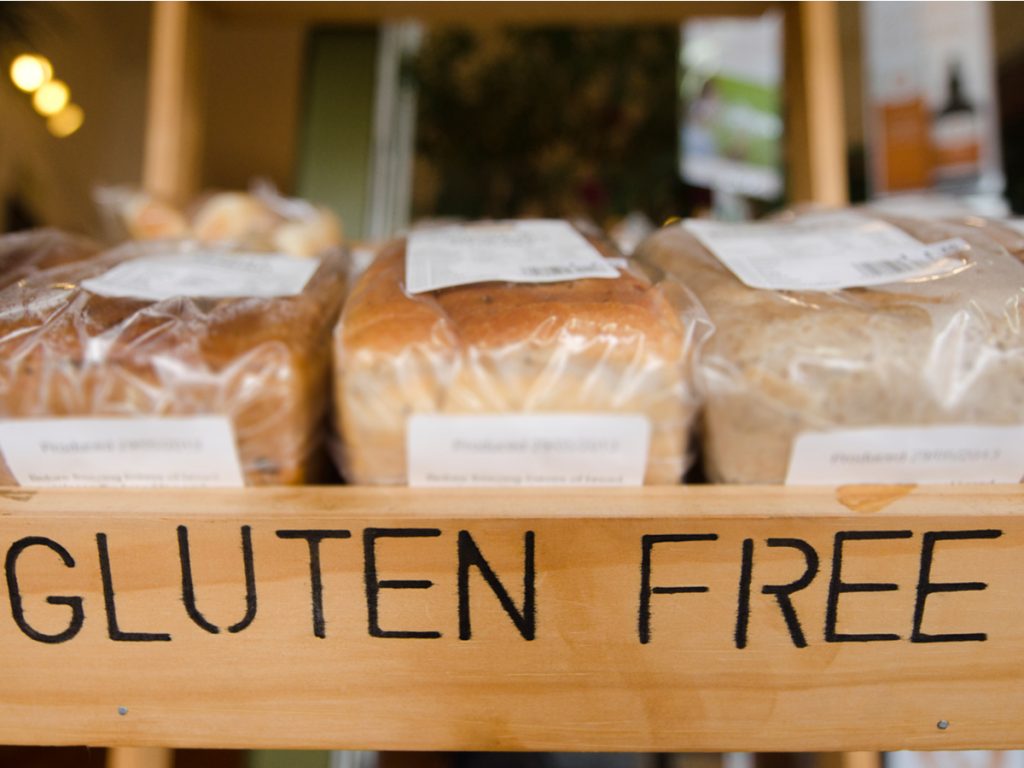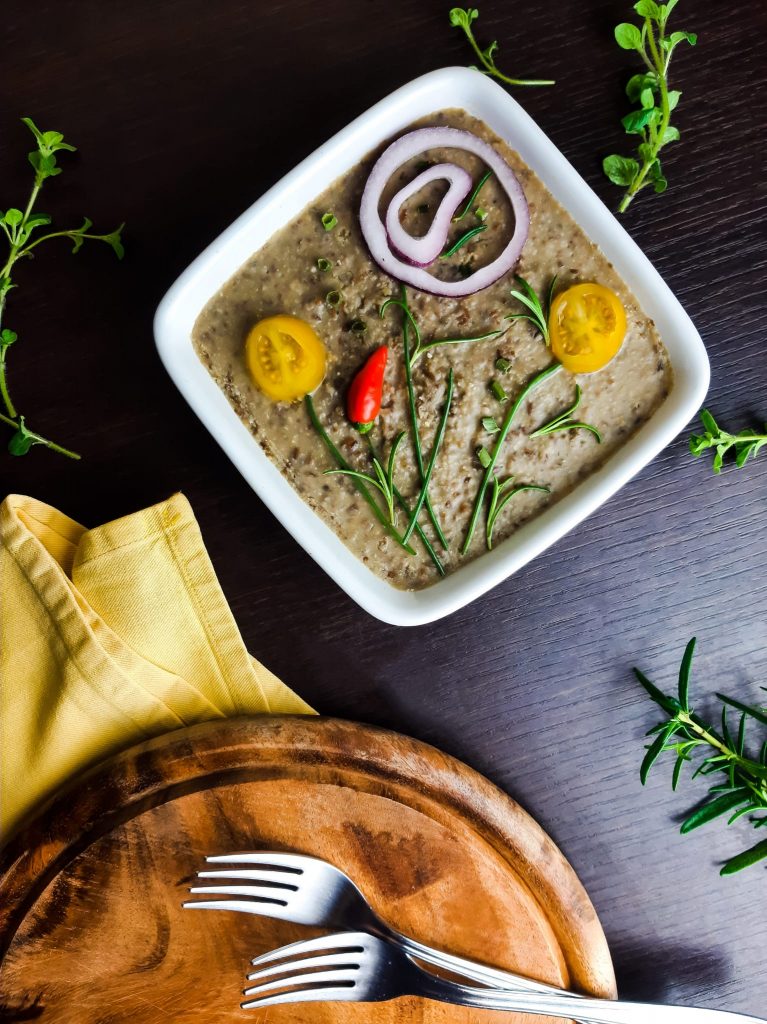La roveja è un piccolo legume antichissimo, originario del Medio Oriente, da molti ritenuto progenitore dei più moderni piselli e conosciuto per questo motivo anche come “pisello selvatico”. In tempi antichi la roveja era coltivata su tutta la dorsale appenninica umbro-marchigiana. In queste zone cresceva anche spontaneamente sul bordo di campi e fossi. Fu una delle colture più diffuse tra le famiglie contadine grazie alla sua resistenza alle basse temperature ed alla scarsità di acqua.

Di colore marrone scuro, rossiccio, verde o grigio, la roveja è poverissima di grassi e ricca di proteine, minerali, fibre e vitamina B1. Purtroppo questo tesoro di sostanze nutritive andò scomparendo col tempo: le piante non potevano essere raccolte meccanicamente per via dei lunghi steli che superano di molto il metro di altezza rendendo impossibile il passaggio delle macchine per la raccolta, quindi veniva falciata a mano, il che si traduce in un lavoro a schiena in giù chinati per ore. Una modalità di coltivazione molto faticosa e poco redditizia, ecco perche è stata praticamente abbandonata ma per fortuna non del tutto dimenticata.
Questo legume, di cui pochi sanno l’esistenza, le nostre nonne, quelle delle Marche e dell’Umbria, se lo ricordano bene ed è grazie a loro e alla volontà di giovani produttori volenterosi che la Roveja sta tornando sulle nostre tavole. C’è una bella storia dietro a questa riscoperta risalente al 1998. Quella di due ragazze, che ripulendo una vecchia cantina trovano un barattolo contenente dei semi sconosciuti e una piccola etichetta scritta a mano, poco leggibile, dove si distingue qualcosa tipo “roveggia”.
I contadini conservavano i semi come un tesoro per non perdere la coltivazione in caso di condizioni climatiche avverse ma questo le due ragazze non lo sapevano. Fu grazie alle loro ricerche e alle testimonianze dei nonni che scoprirono, la natura di quei semi e una grande ambizione: dare nuovo lustro alla roveja ricominciandone la coltivazione e valorizzandone le caratteristiche, promuovendone le proprietà di gusto e nutrizionali.
L’apprezzamento e la richiesta del pubblico cresce portando a produrne oggi quantitativi sempre crescenti. Una storia che non sfugge a Slow Food, l’organismo per la tutela della biodiversità alimentare, che riconosce la roveja come presidio protetto. Un legume antico, unico nel suo genere, legato imprescindibilmente al territorio, ai suoi abitanti e alla loro cultura, testimonianza della memoria che conservano le vecchie mura e le persone di queste zone, spesso afflitte dal terremoto e dalla fatica ma mai spezzate, come il filo che lega le tradizioni che trovano sempre il modo di riaffiorare e vivere in eterno.
Un prodotto perfetto quindi per il mio sformato che, oltre ad essere molto buono e nutriente, è un piatto vegano e soprattutto senza glutine che, per chi non lo sapesse, è la più importante proteina di riserva del grano e di molte altre specie di cereali. Il glutine ha diverse qualità in tecnologia alimentare. Ha un valore nutritivo ridotto ma è un buon emulsionante, per questo ha impieghi versatili in molte preparazioni perchè serve da legante e dona coesione alla farina di grano e ne facilita la panificazione.
Purtroppo l’evoluzione e la velocità delle nostre esigenze sembra sorpassarci. Il grano moderno contiene più glutine rispetto le antiche varietà e probabilmente la digestione dell’uomo non si è adattata alla stessa velocità. Potrebbe essere per questo che si verificano sempre più spesso intolleranze verso gli alimenti contenenti glutine, come la celiachia o la sensibilità al glutine.

Oggi numerosi alimenti senza glutine sono presenti sul mercato, una richiesta crescente anche per via di falsi miti circolanti sul suo conto. Da qualche anno a questa parte, infatti, sempre più persone consumano alimenti senza glutine pur non avendone bisogno. Una tendenza basata su una cattiva informazione e su false convinzioni riguardanti il dimagrimento. Un paradosso per chi purtroppo, questo tipo di alimentazione, è invece una stretta necessità.
Per sensibilizzare le persone su questo delicato tema, il blogger e grafico francese Arthur Coulet ha deciso di eliminare ogni traccia di glutine da dipinti, fotografie e scene di film famosi in tutto il mondo. In questo modo, il grafico ha creato un vero e proprio Gluten free museum aperto a tutti online sulla piattaforma tumblr. Cancellando ogni traccia di glutine da famosi capolavori figurativi, il progetto di Coulet viene da molti interpretato come una provocazione verso la moda delle diete “gluten free” a tutti i costi.
Ad ogni modo vi lascio la mia ricetta, che è quella di un piatto che mette tutti daccordo, e che nulla ha a che fare con il consumismo. Il suo sapore è un caldo legame con la storia e le tradizioni che ci fanno scoprire alimenti sani, frutto della memoria, della passione e della fatica delle persone.
Sformato di roveja
Ingredienti per 4 persone:
• 250 g di roveja secca
• uno spicchio di aglio
• una cipolla
• una patata
• una carota
• sedano
• un rametto di rosmarino
• sale, pepe e olio evo
Procedimento:
Lavate la roveja con acqua fredda e tenete in ammollo per una notte. Sistemate la roveja in una pentola con 3 parti di acqua fredda, coprite, portate a bollore e lasciate sobbollire per circa quaranta minuti. Nel frattempo preparate un soffritto di aglio, cipolla, sedano tritati e tocchetti di carota e patata. Rosolate il tutto e poi unite la roveja con un pò della sua acqua di cottura. Aggiustate di sale e pepe, unite un mazzetto di rosmarino e portate a cottura lentamente in modo da ottenere una cremina densa. Frullate il tutto e trasferite in una teglia da forno. Infornate infine a 180° per circa 10/15 minuti. Servite lo sformato di roveja bello caldo.
Sformato di roveja (Roveja flan)
The roveja is a small, very ancient legume, originally from the Middle East. It is considered to be the ancestor of the most modern peas and therefore also known as wild pea. In ancient times the roveja was cultivated throughout the Umbrian-Marche Apennine ridge. There it also grew spontaneously on the edge of fields and ditches. It was one of the most widespread crops among peasant families thanks to its resistance to low temperatures and scarcity of water.
Dark brown, reddish, green or gray, the roveja is very low in fat and rich in proteins, minerals, fibers and vitamin B1. Unfortunately, this treasure of nutrients disappeared over time: the plants could not be harvested mechanically because of the long stems exceeding one meter in height that made the use of harvesting machines impossible. So, it was harvested by hand and that meant long hours of work bent down. Because of this very tiring and unprofitable cultivation, it has been practically abandoned. Although, fortunately, it’s not completely forgotten.
Our grandmothers, those of Marche and Umbria, remember this legume well and it is thanks to them and willing young producers, that the roveja is returning to our tables. There is a beautiful story behind this rediscovery that dates back to 1998. The story is of two girls who were cleaning an old cellar and found a jar containing unknown seeds. On it was a small handwritten label, barely legible, where something like ‘roveggia’ could be made out.
Farmers kept seeds as a treasure so as not to lose the cultivation in case of adverse weather conditions; but the two girls did not know that. Thanks to their research and the testimonies of their grandparents they discovered the nature of those seeds and a great ambition: to give new luster to the roveja by restarting its cultivation and enhancing its characteristics, promoting its taste and nutritional properties.
The appreciation and demand from the public has grown, leading to the production of ever increasing quantities. The story did not escape Slow Food: the roveja was then recognized as a protected presidium by the organization for the preservation of food biodiversity. An ancient legume, unique of its kind, inextricably linked to the territory, to its inhabitants and their culture. It is a testimony of the memory preserved by old walls and people of these areas, often afflicted by earthquakes and fatigue, but never broken–just like the thread that binds traditions that always find the way to resurface and live forever.
A perfect product therefore for my flan which, in addition to being very good and nutritious, is a vegan dish and gluten-free. For the uninitiated, gluten is the most important protein of wheat and of many other species of cereals and has several qualities in food technology. It has a reduced nutritional value but is a good emulsifier, which is why it has versatile uses in many preparations serving as a binder and giving cohesion to wheat flour thus facilitating the baking.
Unfortunately, the evolution and speed of our needs seems to have overtaken us. Modern wheat contains more gluten than ancient varieties and human digestion has probably not adapted at the same rate. This could be why intolerances towards gluten-containing foods, such as celiac disease or gluten sensitivity, are increasing.
Numerous gluten-free products are on the market today. There’s also a growing demand because of false myths circulating on gluten’s account. In recent years, in fact, more and more people have been consuming gluten-free foods even though they don’t need it. This trend is based on bad information and false beliefs regarding weight loss. A paradox for those who are obliged to such a diet.
To raise awareness on the issue, the French blogger and graphic artist Arthur Coulet has decided to eliminate all traces of gluten from paintings, photographs and scenes of famous films all over the world. In this way, the graphic designer has created a real Gluten Free Museum open to all online on Tumblr. By erasing all traces of gluten from famous figurative masterpieces, Coulet’s project is interpreted by many as a provocation towards the fashion of gluten free diets at all costs.
Nevertheless, I leave you my recipe. It’s an all-round pleaser dish that has nothing to do with consumerism. Its flavor represents a warm link with history and traditions that make us discover healthy foods as a result of people’s memory, passion and effort.

Roveja Flan
Ingredients for 4 people:
• 250 g of dry roveja
• 1 clove of garlic
• 1 onion
• 1 potato
• 1 carrot
• celery
• a sprig of rosemary
• salt, pepper and extra virgin olive oil
Method:
Wash the roveja with cold water and let it soak overnight. Place the roveja in a pot with 3 parts of cold water, cover, bring to a boil and let it simmer for about forty minutes. In the meantime, prepare a sauté of garlic, onion, chopped celery and pieces of carrot and potato. Brown everything and then add the roveja with a little of its cooking water. Season with salt and pepper, add a bunch of rosemary and cook slowly in order to obtain a thick cream. Blend everything and transfer to a baking sheet. Finally bake at 180 degrees for about 10/15 minutes. Serve the roveja flan nice and hot.
Hungry for more recipes? Try making these dishes:
Baci di Romeo e Giulietta
Scallops with Thyme and Saffron Potato Cream



